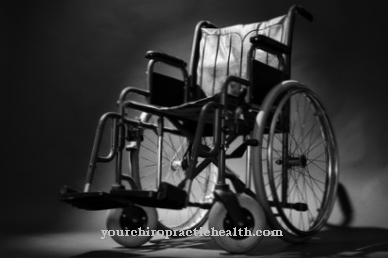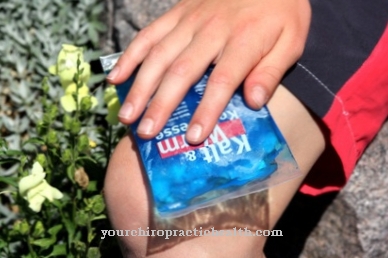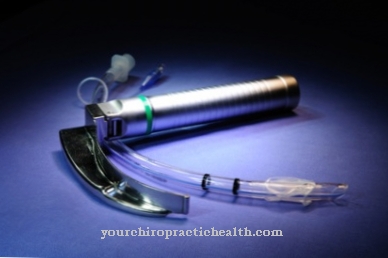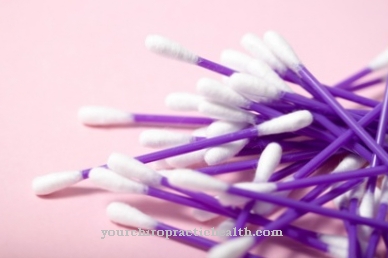At a corset it is a stable medical construction that belongs to the group of orthoses. It serves to stabilize the human trunk.
What is a corset?

The corset is one of the medical aids used in orthoses. This stable support structure is either made individually by an orthopedic technician on the instructions of a doctor or manufactured in an industrial manner.
The corset is used to immobilize, stabilize, relieve or correct the human trunk or limbs.
When the corset is put on, a direct connection is established between the instrument and the parts of the body to be treated. In this way, the functionality of the corset can be guaranteed.
A corset is not to be confused with a prosthesis. Its material consists of rigid plastic or splint-leather-splint fabric.
Shapes, types & types
A corset is made either individually by taking an impression of the patient, or from a prefabricated segment. There are also active and passive corsets.
One of the most common active corsets is the Milwaukee corset. The most important component is the pelvic cage. From the head, a metal rod on the back and two other rods run along the stomach. This creates the so-called reminder pad, which is located under the chin. It is used to enable children to maintain an upright posture.
A proven passive corset is the Boston corset, which is made using the modular technique. The Boston corset allows the pelvis and lumbar spine to be placed close to the patient. The pads exert direct pressure on the spine towards the corrective axis.
The Cheneau corset is also a passive corset. The structure and technology of the orthosis are similar to the Boston corset, but it has the advantage of including the chest in the treatment.
Thermoplastic corsets are another variant. These are made to measure, in which the constitution of the patient is taken into account individually. They are made with the help of a plaster cast and in the direction of pull of the spine. A model is then created with a spout. The necessary corrections can then be made without any problems. In this way, the corset can be made more adaptable. However, the production is significantly more complex than the module technology.
Structure & functionality
The construction of a corset is based on different principles. Both the statics and the dynamics of the human skeletal system are supported. In some cases, they are only made possible by the orthosis. The special structure of the corset ensures that the body section to be treated is immobilized, stabilized or relieved.Sometimes it may also be necessary to partially restrict the mobility of a certain point.
Some corsets serve as a support insert and are supposed to relieve the skeleton, for example in Perthes disease or other degenerative diseases.
Orthopedic corsets are called Back brace or Trunk orthosis. Passive trunk orthoses are support corsets. They are primarily used to support and relieve pain patients or people who suffer from an unstable spine.
With the help of active back orthoses, on the other hand, abnormal statics of the spine such as osteoporosis (bone loss), Scheuermann's disease, scoliosis, hyperlordosis (hollow back) or kyphosis can be treated. They are used particularly with children and adolescents to steer their growth in the right direction. Adults can also improve their posture or reduce their pain with an active trunk orthosis. Some trunk orthoses are also used to stretch or straighten the spine.
A corset is usually placed on the patient's back. As with a splint, close contact with the trunk is extremely important in order to achieve a positive effect. For further stabilization, the splint is attached to the patient's abdomen and fastened to a support strut. If the trunk can no longer perform its own movements, the corset is correctly positioned.
You can find your medication here
➔ Medicines for painMedical & health benefits
With the help of corsets and orthoses, great medical success can be achieved, so that there are high health benefits. The medical instruments can be used by babies as well as adults in order to effectively treat a wide variety of skeletal disorders. A corset is usually used for inflammatory processes in the spine to enable it to be immobilized.
A common area of application for corsets such as the Boston corset or the Milwaukee corset is scoliosis. This is a curvature of the spine. With scoliosis, the person's spine takes on an S-shape. An unnatural rotation of the spine is also noticeable. In addition, lordosis, in which the spine leans sharply back, or kyphosis, in which the spine points forward, can occur. Even with a very pronounced scoliosis, wearing a corset can help.
However, the corset may only be used if the direction of growth of the spine can still be influenced. So it must still be growing, which is the case with children and adolescents.
At the beginning of the treatment, the corset is worn irregularly so that the young patient can get used to the device. In the further course, the wearing time increases. After all, the patient has to put the brace on for 23 hours a day. The successful treatment of a growth deformity requires a high degree of consistency.
The corset has also proven itself in the successful treatment of bone fractures.
























.jpg)



